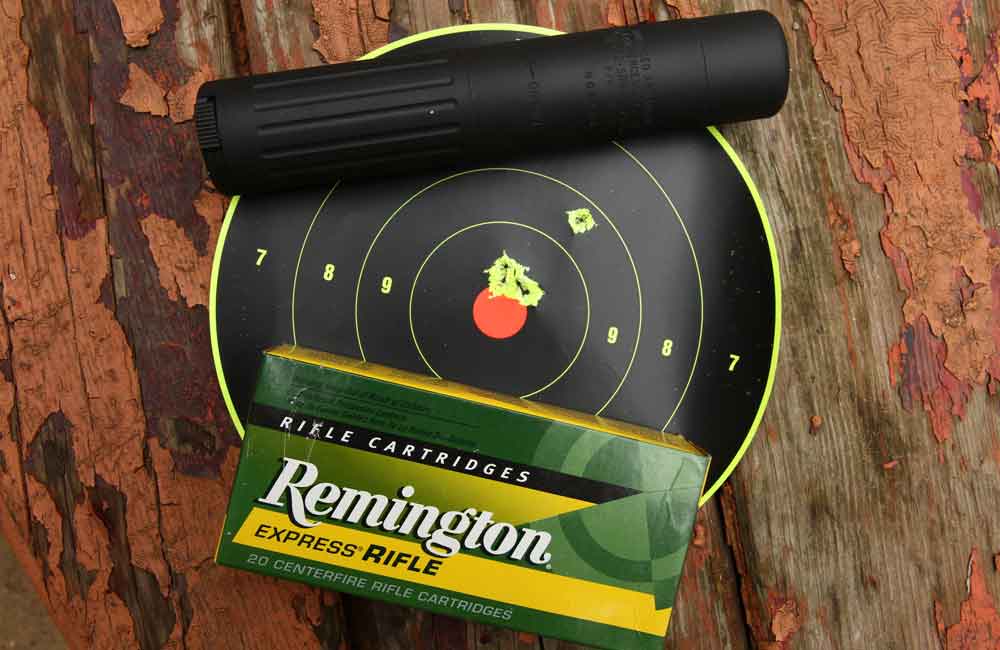
Hanging a big hunk of metal off the muzzle of your gun is going to have an effect on accuracy, but exactly how much … and why?
- Barrel harmonics will change with a suppressor.
- A suppressor will shift the point of impact consistently with each mounting.
- This shift will be different for each firearm it's mounted on.
- Suppressors generally improve a firearm's accuracy.
When it comes to accuracy while shooting with a suppressor, we have competing dynamics at play. On one hand, the suppressor should cause a shift in point of impact, and perhaps even accuracy, because we’ve just attached a half-pound, up to a pound and a half, of metal on the end of the barrel. When you fire a rifle, the barrel hums like a tuning fork. The muzzle whips around like crazy. The point of impact depends largely on where in the “cycle of whipping around” the muzzle is pointed when the bullet pops out of the crown.

An inaccurate barrel has inconsistent harmonics, and the bullet leaves when the muzzle is basically in a random location at each shot. An accurate barrel is one that either has little or no movement, or the bullet leaves at the same location in space of the muzzle’s movement.
The Browning BOSS system was an attempt to tune the barrel harmonics so that you have a consistent release. The BOSS has an adjustable weight, one that moves back or forth and changes the harmonics, and you do a trial-and-error test to see which position is best. (I can’t help but wonder just how much of the improvement in accuracy is created simply by the shooter getting more practice.) So, hanging a chunk of metal on the muzzle should change accuracy.
On the other hand, the suppressor can improve accuracy by stripping away the turbulent gases from the muzzle, the location where the bullet is at its most unstable and most suggestible to change. Which one wins?
It turns out that the gas-stripping variable is larger than the random harmonic change variable. (Maybe that’s why Browning let the BOSS fade; the improvement wasn’t worth the effort?) Most suppressors actually increase accuracy. Few change the point of impact, and when they do, it's by a minimal amount. While the direction and distance of the change is random on each pairing, it is consistent with the pair. That is, if you slap a suppressor on your rifle, and find it shifts the group half an inch low-left, the shift will go away when you take the suppressor off. And, it will return, in the same direction and amount, when you put it back on. But, it will not necessarily have the same change on the next rifle in your rack.
Now, there is accuracy, and then there is accuracy. For most shooters (and I don’t mean to be insulting here), the accuracy shift is one they will not notice. For example, I tested a 9mm suppressor on a high-end 1911, a pistol built with a bank-vault-like fit. Over sandbags, the pistol was capable of less than 2-inch groups at 25 yards. If I knocked off my usual and excessive coffee consumption, I could get groups down to close to an inch, center to center. That’s basically five shots touching at 25 yards … from a pistol.
The suppressor I tested shifted the group center maybe an inch. So, a shift at 25 yards that isn’t even half the apparent width of the front sight blade, this when shot over sandbags? Admit it, how many of you can shoot a sub-2-inch group, even off of a rest, with your current pistol, ammo and practice level? On demand? If I had handed the pistol to someone who could shoot a 3-inch group at best (which is still pretty darned good) the change in point of impact would not be as great as the group itself. The overlap of the groups would mean no change was apparent, and it would take some very careful measuring to even indicate there had been a shift.

I did the same thing with a top-flight AR, using match ammo. And the numbers were pretty much the same. If I changed my regular scope to a high-X one (Leupold 6.5-20) I could shoot sub-MOA groups, and the suppressor caused a change of almost an inch at 100 yards. If you could not shoot sub-MOA groups, you would not be able to determine if any change at all had occurred.
Editor's Note: This article is an excerpt from Gun Digest Book of Suppressors.

Next Step: Get your FREE Printable Target Pack
Enhance your shooting precision with our 62 MOA Targets, perfect for rifles and handguns. Crafted in collaboration with Storm Tactical for accuracy and versatility.
Subscribe to the Gun Digest email newsletter and get your downloadable target pack sent straight to your inbox. Stay updated with the latest firearms info in the industry.

![Best Concealed Carry Guns In 2025 [Field Tested] Wilson Combat EDC X9S 1](https://gundigest.com/wp-content/uploads/Wilson-Combat-EDC-X9S-1-324x160.jpg)


![Best 9mm Carbine: Affordable PCCs [Tested] Ruger Carbine Shooting](https://gundigest.com/wp-content/uploads/Ruger-Carbine-Shooting-100x70.jpg)
![Best AR-15: Top Options Available Today [Field Tested] Harrington and Richardson PSA XM177E2 feature](https://gundigest.com/wp-content/uploads/Harrington-and-Richardson-PSA-XM177E2-feature-100x70.jpg)

There are two types of suppressor. Ones with symmetrical internals and ones with asymmetrical internals. Asymmetrical internals induce yaw which reduces the ballistics coefficient. This does not necessarily change the accuracy however it introduces error into a ballistics calculation. If you are shooting an AR that does not matter but if you are ranging targets and dialing elevation based on your ballistics calculator then it does.